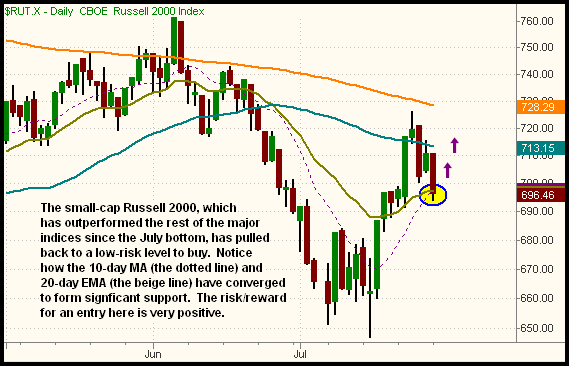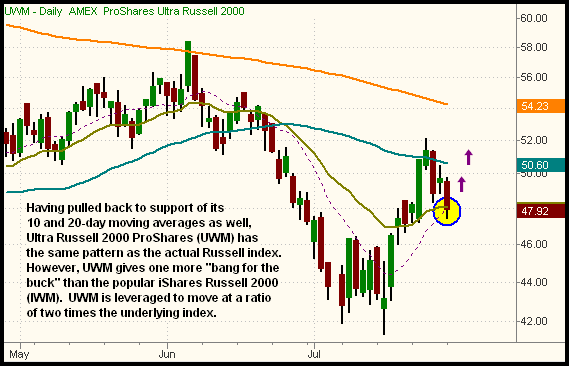|
The Wagner Daily ETF Report For July 29
The stock market got off to an ugly start this week, as the major indices swiftly erased the gains of last Friday's bounce, and quite a bit more. Tumbling well below last week's lows, the S&P 500 and Dow Jones Industrial Average fell 1.9% and 2.1% respectively. The Nasdaq Composite similarly lost 2.0%, but held on to support of its July 22 low. The small-cap Russell 2000 lost 2.0%, as the S&P Midcap 400 declined 1.2%. All the main stock market indexes closed at or near their worst levels of the day, positioning stocks for a bit of downward pressure on today's open.
The possible silver lining of yesterday's storm clouds is that lighter volume accompanied the sharp losses. Total volume in the NYSE fell 10%, while volume in the Nasdaq limped in 3% below the previous day's level. When stocks are trying to reverse from a sharp downtrend, it's positive when volume dries up on the "down" days. This tells us that institutions, which are responsible for more than half of the market's activity on an average day, have not been rushing for the exit doors whenever stocks pull back. It's important to note that turnover also declined last Thursday, when the major indices lost a similar percentage to yesterday. The negative, however, is that market internals were nasty. In both the NYSE and Nasdaq, declining volume exceeded advancing volume by a margin of approximately 5 to 1. The selling was broad-based, not confined to just a few industry sectors.
Since printing their intermediate-term lows on July 15, the major indices have been attempting to turn their counter-trend bounces into legitimate trend reversals. Since the bullish reversal that occurred mid-month, the small-cap Russell 2000 has unequivocally led the pack higher. From their July 15 intraday lows to their July 23 intraday peaks, the S&P 500 gained 7.6%, the Dow Jones Industrial Average 8.0%, and the Nasdaq Composite 8.4%. There were pretty respectable gains in a short period of time. But by comparison, the Russell 2000 zoomed 12.2% higher during the same period. It was also the only index to rally enough to test resistance of its 50-day MA (though it has since fallen back below it). Over the past three days, the Russell 2000 has retraced some of its gains, along with the rest of the major indices, but its current chart pattern now presents a low-risk buy entry into the small-cap index:

Notice how the Russell 2000 has pulled back to support of both its 10-day moving average and 20-day exponential moving average, which have converged right in the vicinity of yesterday's close. The Russell 2000 has also showed relative strength throughout the pullback of the past three days. The S&P 500 and Dow Jones Industrial Average, for example, have both retraced to their 61.8% Fibonacci retracement levels, from their July 15 lows to July 23 highs. The Nasdaq Composite has retraced half of its recent gain. But since it showed relative strength on the way up, it should not surprise you to know that the Russell 2000 has only pulled back to its 38.2% retracement level. If stocks are going to resume their uptrends in the near-term, the Russell 2000 should continue to lead the way, and the current pullback provides a very low-risk entry to take a position. The vehicle we prefer for buying the Russell 2000 is Ultra Russell 2000 ProShares (UWM). Notice how its daily chart nearly matches the performance of the Russell 2000 daily chart:

Why buy UWM instead of the more well-known iShares Russell 2000 (IWM)? The main reason is the leverage. If the Russell 2000 rallies 1%, UWM will gain 2% (and vice versa). Since indexes typically have much lower volatility than industry sector ETFs, the leveraged ProShares family of ETFs gives us more "bang for the buck." This is especially important for traders with small accounts, as not a lot of buying power is required to be tied up. As with yesterday's setup in UUP (which did not yet trigger), subscribers should note our detailed trigger, stop, and target prices for the Ultra Russell 2000 ProShares (UWM) below.
Yesterday's sell-off may have been a disappointment to the bulls, but it was not shocking to us. In yesterday's commentary, we said of the state of the broad market that, ". . .we are neutral on the near-term. The corrective action on July 24 was healthy, and stocks recovered a bit of their gains the following day. However, the major indices, with the exception of the Russell 2000, still remain firmly entrenched in primary, long-term downtrends. The S&P 500 and Dow Jones Industrial Average both fell back below their 20-day EMAs as well. This all means the near-term trends could be choppy and indecisive, which is why we are neutral. As for the intermediate-term, it's looking more and more likely that the major indices will not be violating their July lows anytime soon. Just don't forget that we're still in a bear market. Large, unexpected gap downs are common in such an environment. Overall, odds probably favor the long side of the market right now, but stay alert and cautious until the major indices prove they can move above last week's highs. Buying with reduced share size on all new positions is a great way to sensibly reduce risk." These thoughts pretty much summed up yesterday's subsequent action. The major indices are still holding well above their July lows, but are not in a hurry to move higher. We're indeed content with having a neutral bias on the short-term, but small-caps are the place to be if buying anything.
Open ETF positions:
Long - EWH
Short - (none)
Deron Wagner is the Founder and Head Trader of both Morpheus Capital LP, a U.S. hedge fund, and Morpheus Trading Group, a trader education firm launched in 2001 that provides daily technical analysis of the leading ETFs and stocks. For a free trial to the full version of The Wagner Daily or to learn about Wagner's other services, visit MorpheusTrading.com or send an e-mail to deron@morpheustrading.com.
|